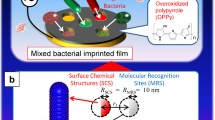Abstract
The rapid detection of Salmonella typhi can be accomplished by developing nanobiosensor kits. Accordingly, in the present study, a molecularly imprinted polymer (MIP) was developed, formed via covalent bonds among methacrylic acid (MAA) monomers and hydrogen bonds between MAA and antibodies. Using this MIP, S. typhi antigen was detected with a fluorescence converter. The S. typhi concentration could be determined at 10 colony/mL (minimum) in polluted water. A spectrofluorometer was used to quantify the findings. In addition, Escherichia coli was inseminated in an aqueous environment containing S. typhi, and no interference with the sensor function was found. The sensor sensitivity was measured for 60 days, and the sensor performance was verified for 56 days. Thereafter, the performance diminished. The present findings indicated the sensitive and precise role of the sensor in detecting S. typhi antigens at concentrations of 10−1–109.








Similar content being viewed by others
References
Ahari H, Razavilar V, Akbari B, Motallebi A, Anvar A, Mohammadi N (2014) Comparison of potentiometry and spectroscopy-based modified nanoparticles linked to antibodies for detection of Staphylococcus aureus exotoxin. Iran J Nutr Sci Food Technol 8(4):247–258
Anvar SA, Razavilar V, Akbari B, Motallebi A (2014) Detection of Salmonella typhi in aquatic environment using nano biosensor based on fluorescence. Int J Biol Pharm Allied Sci 3(11):2595–2615
Foroshani NS, Karami A, Pourali F (2013) Simultaneous and rapid detection of Salmonella typhi, Bacillus anthracis, and Yersinia pestis by using multiplex polymerase chain reaction (PCR). Iran Red Crescent Med J 15(11):e9208
Frimat JP, Bronkhorst M, de Wagenaar B, Bomer JG, van der Heijden F, van den Berg A et al (2014) Make it spin: individual trapping of sperm for analysis and recovery using micro-contact printing. Lab Chip 14(15):2635–2641
Javanbakht M, Fard SE, Mohammadi A, Abdouss M, Ganjali MR, Norouzi P, Safaraliee L (2008) Molecularly imprinted polymer based potentiometric sensor for the determination of hydroxyzine in tablets and biological fluids. Anal Chimica Acta 612:65–74
Kan X, Xing Z, Zhu A, Zhao Z, Xu G, Li C, Zhou H (2012) Molecularly imprinted polymers based electrochemical sensor for bovine hemoglobin recognition. Sens Actuators B Chem 168:395–401.
Kryscio DR, Peppas NA (2012) Surface imprinted thin polymer film systems with selective recognition for bovine serum albumin. Anal Chim Acta 718:109–115
Kumar S, Tripathi V, Garg S (2013) Antibiotic resistance and genetic diversity in water-borne Enterobacteriaceae isolates from recreational and drinking water sources. Int J Environ Sci Technol 10(4):789–798
Lin HY, Rick J, Chou TC (2007) Optimizing the formulation of a myoglobin molecularly imprinted thin-film polymer—formed using a micro-contact imprinting method. Biosens Bioelectron 22(12):3293–3301
Marotta G, Simeone M, Nazzaro C (2014) Product reformulation in the food system to improve food safety. Evaluation of policy interventions. Appetite 74:107–115
Meemken D, Tangemann AH, Meermeier D, Gundlach S, Mischok D, Greiner M et al (2014) Establishment of serological herd profiles for zoonoses and production diseases in pigs by “meat juice multi-serology”. Prev Vet Med 113(4):589–598
Moradi S, Englezos P, Hatzikiriakos SG (2014) Contact angle hysteresis of non-flattened-top micro/nanostructures. Langmuir 30(11):3274–3284
Rani N, Vajpayee P, Bhatti S, Singh S, Shanker R, Gupta KC (2014) Quantification of Salmonella typhi in water and sediments by molecular-beacon based qPCR. Ecotoxicol Environ Saf 108C:58–64
Sankar S, Vadivel K, Nandagopal B, Jesudason MV, Sridharan G (2014) A multiplex nested PCR for the simultaneous detection of Salmonella typhi, Mycobacterium tuberculosis, and Burkholderia pseudomallei in patients with pyrexia of unknown origin (PUO) in Vellore, South India. Mol Diagn Ther 18(3):315–321
Shin HS, Yun HJ, Baek KH, Ham YH, Park KS, Kim DP et al (2012) The effect of thermal annealing on pentacene thin film transistor with micro contact printing. J Nanosci Nanotechnol 12(7):5325–5329
Yoshida W, Kezuka A, Murakami Y, Lee J, Abe K, Motoki H et al (2013) Automatic polymerase chain reaction product detection system for food safety monitoring using zinc finger protein fused to luciferase. Anal Chim Acta 801:78–83
Acknowledgements
We would like to thank the Nanolab of Food and Drug Organization, Ministry of Health. In addition, we extend our gratitude to Metallurgical Engineering Lab of Amirkabir University and Mabna Food Product Laboratory for their assistance.
Author information
Authors and Affiliations
Corresponding author
Ethics declarations
Conflict of interests
All authors declare that they have no conflict of interests.
Additional information
Editorial responsibility: I. Akkurt.
Rights and permissions
About this article
Cite this article
Razavilar, V., Ahari, H., Akbari Adergani, B. et al. A central composite face-centered design for optimizing the detection of Salmonella typhi with a fluorescence nanobiosensor using the microcontact method. Int. J. Environ. Sci. Technol. 16, 4637–4646 (2019). https://doi.org/10.1007/s13762-018-1871-z
Received:
Revised:
Accepted:
Published:
Issue Date:
DOI: https://doi.org/10.1007/s13762-018-1871-z




